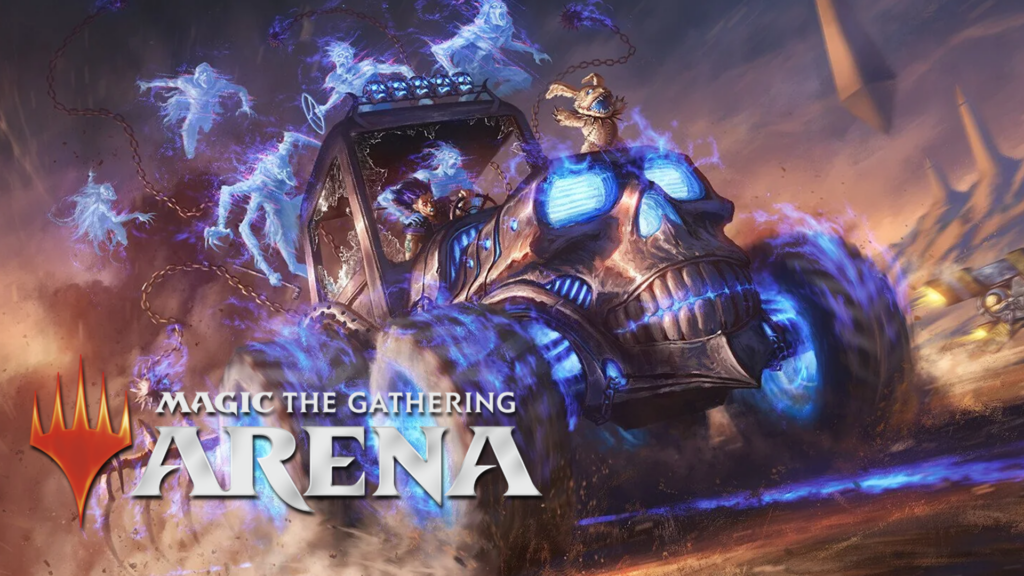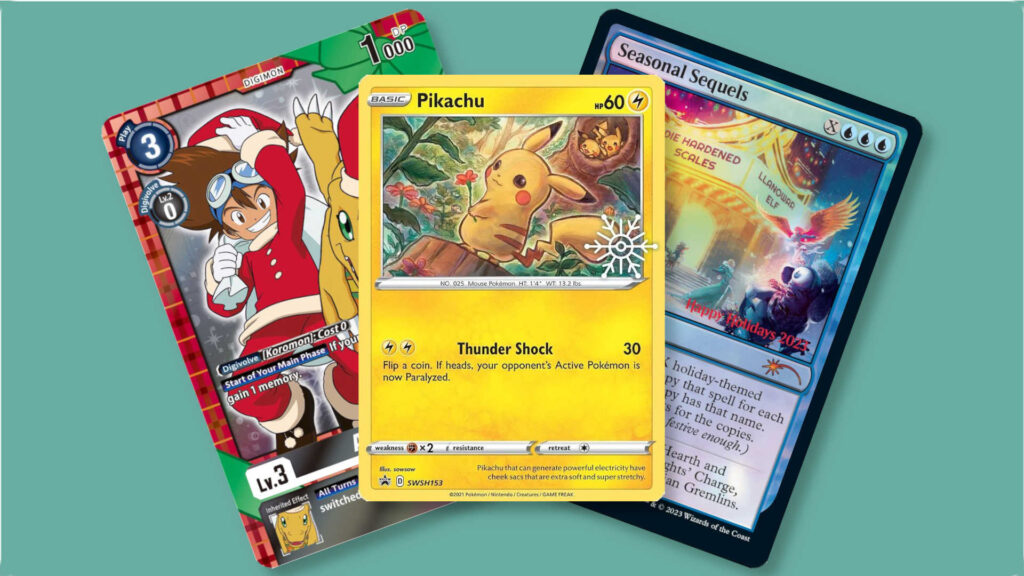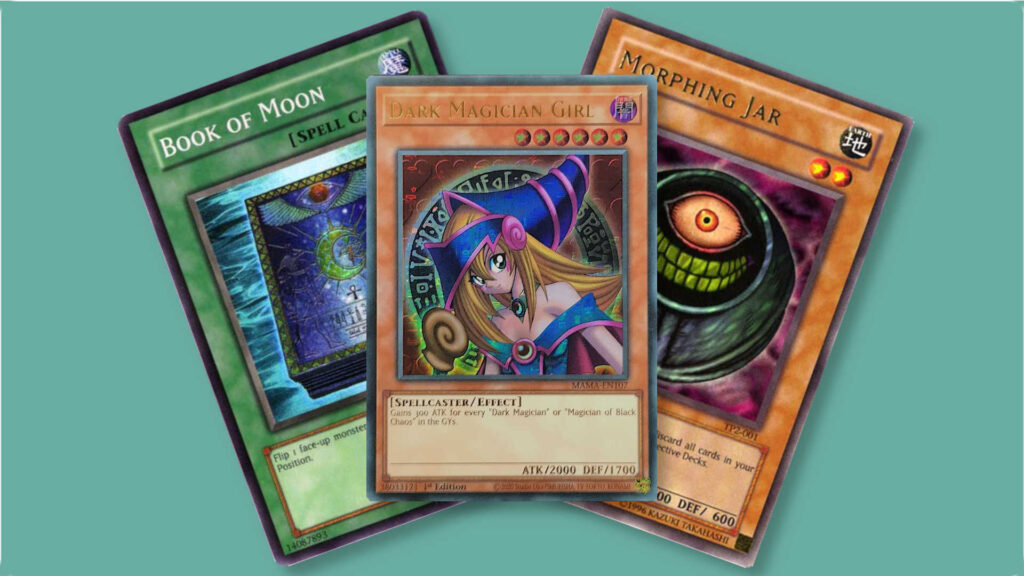Images courtesy of Wizards of the Coast
Aetherdrift releases on Magic Arena on February 11th, and I’m more than ready to get drafting! Jumping into a new draft format can be tough, so today let’s break down the draft archetypes and take our first looks at the format.
Table of Contents
ToggleA Look at the Draft Archetypes of Aetherdrift
Each color pair in this set has two signpost uncommons, one Vehicle/Mount and one non-Vehicle/Mount. The non-Vehicle signposts seem to do a better job telling us what each color pair is up to this time around, though it’s still worth looking at the Vehicles.
Azorius Artifact Value – White Blue
This is one of two-color combinations that rewards you for playing lots of artifacts. Cards with affinity for artifacts like Voyage Home and Gearseeker Serpent are direct payoffs, while Guidelight Pathmaker gets more powerful the more options you can find with it.
Blue has the highest density of artifacts in Aetherdrift, but white isn’t too far behind. That said, you shouldn’t expect to be landing your big affinity cards super early. Assume you’ll get a three- to four-mana discount if your deck really gets there on artifact count. I’m most interested in payoffs that directly accrue card advantage, like Transit Mage or the aforementioned Voyage Home. I want those cards backed up with efficient artifact creatures like Diversion Unit and Nesting Bot.
This looks like one of the more straightforward archetypes to build in this set, as it’s fairly obvious which cards fit into the archetype.
Dimir Artifact Bleed – Blue Black
Dimir is the second artifact-based deck in the format, but with a more incremental game plan. Cards like Haunted Hellride will let you get in for a little extra damage here and there until you’re ready to close out the game with a finisher like Haunt the Network.
Black is a little lower on artifact count than both white and blue, but it does have a few bangers at lower rarities. Pactdoll Terror is one of the big payoffs for this color pair, as it will likely cause nice life swings if it manages to survive. Grim Bauble will almost certainly be a premium common in all black decks, but it has obvious synergies here.
This deck’s biggest challenge will likely be stabilizing enough to actually enact the game plan of bleeding your opponents out, as the aggro decks will apply serious pressure. Prioritize early interaction and roadblocks to give yourself the best chance of making it to the end game.
Rakdos Max Speed Aggro – Black Red
This color combination wants to hit max speed as fast as possible. Gastal Thrillseeker will get you from zero speed to two when it comes down, and Apocalypse Runner will help your early creatures get in for more damage while offering a slight bump to your life total.
Rakdos seems poised to be one of the stronger color combinations going into the format. Aggro strategies tend to excel earlier in most limited formats, and the strategy here is pretty straightforward. Look for creatures like Dynamite Diver and Engine Rat that can get in for damage early on even if they don’t have start your engines! themselves. As always, there’s a ton of good removal in these colors as well, so I’d be really surprised if this deck isn’t successful.
Gruul Exhaust Midrange – Red Green
Gruul (red/green) is a midrange deck based around the exhaust mechanic. You’re mostly looking to play strong on-curve threats and follow up with powerful exhaust activations as the game goes on. Boom Scholar is the more on-the-nose signpost uncommon here, directly making these abilities cheaper. Rocketeer Boostbuggy is actually a potentially powerful early play, as it can attack as a 4/3 on turn three and start generating Treasure tokens, which also help pay for exhaust costs!
These decks will likely be at their best when they use powerful exhaust cards to supplement the midrange game plan as opposed to going all-in on as many exhaust cards as possible. Cards like Elvish Refueler seem cool to get the synergies rolling, but not mandatory for success. Exhaust creatures that only affect themselves, like Pacesetter Paragon, look enticing but prone to getting blown out by removal. Their strength will often come from threat of activation. My guess is that this will likely be a bit of a middle-of-the-road archetype when not propped up by powerful higher rarity cards.
Selesnya Vehicle/Mount Midrange – Green White
Selesnya (green/white) is another midrange with a heavier focus on Vehicles and Mounts. Lagorin, Soul of Alacria seems like a great payoff for the strategy as long as you can keep it saddled. Veteran Beastrider is a sneaky enabler, letting you untap creatures you used to crew and saddle earlier in the turn. It’s also an above-rate threat on its own.
This will be one of the stronger archetypes in the set. Back in Outlaws of Thunder Junction, Selesnya Mounts was arguably the strongest archetype. This set has plenty of Mounts worth saddling up, and the fact that they can saddle other Mounts makes it easier to jam a bunch of them into a deck without specifically balancing enablers and payoffs. Lagorin in particular looks incredible; if it’s followed up by any other Mount it will immediately become a major problem. In general, I’ll prioritize Mounts over Vehicles in these decks.
Orzhov Max Speed Attrition – White Black
Orzhov (white/black) is another max speed deck, but with a less aggressive game plan. Embalmed Ascendant provides a lot of power and toughness across two bodies while threatening to drain your opponent out once your speed is maxed out. Dune Drifter theoretically helps with the grindy game plan by bringing back an early creature which can then crew the Vehicle, but it’s not a terribly efficient rate. I’m a lot more excited for the Embalmed Ascendant.
This looks like another deck that’s hard to pull together consistently. The start your engines! cards in this color combination don’t excite me as much as in Rakdos, which I think has both better payoffs and an easier time actually hitting max speed. This might be one of those situations where you end up in the archetype when it’s clearly open or you have powerful rares. One thing I do want to keep an eye on is a potential reanimator deck in these colors, as you have access to both Tune Up and Back on Track along with cards like Shefet Archfiend that cycle themselves into the graveyard. I don’t expect to see this a ton, and the last dedicated reanimator archetype in Duskmourn was pretty bad, but keep it in mind.
Izzet Discard Aggro – Blue Red
We’ve got another aggro deck here, but this time with a discard theme. Boosted Sloop is an enabler that doesn’t need to attack itself to let you start drawing and discarding. Broadside Barrage gives you a one-time loot effect stapled onto a reasonably priced removal spell.
I really want this theme to work, but I have some concerns. Most of the payoffs for this strategy are at higher rarities, and while I like cards like Marauding Mako and Scrounging Skyray, they don’t provide any value once answered. Putting all of your eggs in one of these baskets and cycling a bunch of cards looks bad when the creature inevitably eats a removal spell, so I think you’ll be more likely to make Izzet work in this set if you don’t lean too hard on those synergies. I’ll still take the powerful payoffs, I just won’t prioritize the lower-level enablers as much.
Golgari Graveyard – Black Green
Golgari (black/green), as usual, wants to utilize the graveyard for value. Broodheart Engine reminds me a lot of the classic Nyx Weaver, letting you fill the graveyard over time and eventually buying back a threat. Thundering Broodwagon is another Vehicle that doesn’t play directly into the theme, though it offers good value on a six-drop Vehicle and can be cycled if you really need to.
This color has a few options for self-mill like Carrion Cruiser, Dredger’s Insight, and Pothole Mole. Aside from these cards giving you card selection, your main payoffs for filling your graveyard at lower rarities appear to be things like Chitin Gravestalker and Ooze Patrol. These payoffs aren’t terribly exciting, but they’re decent enough. I’m a lot more likely to go hard on these synergies with a rare payoff like Aatchik, Emerald Radian.
Boros Vehicle/Mount Aggro – Red White
Boros (red/white) is an aggro deck that wants to play Vehicles and Mounts. Cloudspire Coordinator provides a ton of value on a two-mana body between the scry 2, the token-generating ability, and the 3/1 body. Cloudspire Skycycle immediately strengthens your other Vehicles and Mounts while potentially being able to chip in for incidental damage in the air later.
Going into the format, this is my pick for best color combo. Aggressive Boros decks have been quite successful in recent sets, and I think all the tools it needs to thrive are here. In particular Cloudspire Coordinator seems like the most pushed signpost uncommon, but you’ve got plenty of other early creatures, powerful Mount synergies, and removal options like the classic Lightning Strike. There’s even some start your engines! overlap for what that’s worth.
Simic Exhaust Ramp – Green Blue
Simic (green/blue) is a ramp deck based around the exhaust mechanic. Skyserpent Seeker exemplifies this strategy as a combination early roadblock and midgame ramp card. Ranger’s Aetherhive more explicitly rewards activating multiple exhaust abilities, and those Thopter tokens can really add up!
I like the late game potential of Simic, but as I’ve said with a couple of other color combinations, you’ll likely need to prioritize ways to fend off early assaults and stabilize later. Jibbirik Omnivore and Midnight Mangler both block well, and I’m probably happy to use Autarch Mammoth and Migrating Ketradon to close the gap later on. You likely don’t need to prioritize ramp like Veloheart Bike, which will probably wheel if you want it.
Tips and Tricks for Aetherdrift Draft
- I mentioned before that Gastal Thrillseeker can get you from zero to two speed the turn it comes down. Start your engines! is a weirdly-worded ability. The once-per-turn restriction on incrementing your speed doesn’t count going from zero to one. Gastal Thrillseeker happens to immediately damage the opponent when it comes down, but you can get similar results with any other start your engines! card if you can get through for damage the same turn you start said engine. This places emphasis on your one-mana creatures to get the wheels turning in decks that want max speed, so prioritize them accordingly.
- Exhaust abilities can be activated at instant speed. You need to be extra aware of your opponent’s board and mana in this format. While I don’t think you’ll often want to just hold up mana for these abilities without other instant speed options, you also don’t want to lose games to on-board tricks.
- This set has a cycle of legendary creatures at uncommon, all being vanilla (meaning they don’t have abilities.) I think less experienced players will be easily convinced by the big numbers, but I’m mostly not looking to play them. Caelorna, Coral Tyrant might have some defensive utility in slower blue decks but will never help you directly win a game. Kalakscion, Hunger Tyrant and Tyrox, Saurid Tyrant both hurt if they connect but will often trade off with less expensive creatures. Terrian, World Tyrant won’t trade off easily, but the triple green mana requirement will leave it uncastable in too many situations, and without evasive abilities it can also easily be stonewalled. Sundial, Dawn Tyrant is the one I think you should play more often than not, as it’s well rounded in stats, cheap, and easy to cast.
Addendum: Lessons From Week One
Now that the set’s been out for about a week, I’ve learned a lot about how this format actually plays out. As such, I wanted to list a few quick lessons here for anyone starting their Aetherdrift draft journey here.
- Despite being a racing-themed set, the format is a lot slower than you’d think. Aggro is not unviable, but most matchups end up being midrange grindfests. Most decks have plenty of options for gumming up the board early, so you need ways to win the long game.
- Green is easily the best-performing color so far, and white is the worst. Green’s creatures are highly efficient in a set where most creatures are a bit toned down to (attempt to) allow Vehicles to thrive, while white lacks the power and depth at common to make it reliable. Any combination of the Sultai colors (green, blue and black) has proven to be consistently effective.
- Since the format is slow, it’s easier to run additional colors. Color fixing is powerful and abundant.
- Efficient mana usage is key in those long-game slogs. In addition to moving your mana curve higher, having mana sinks in the form of Exhaust abilities is vital.
- Yes, this is a Vehicle set. No, most of them aren’t fantastic. One of the easiest ways to lose in this format is to draw a bunch of them without the ability to crew them. You need to be very cognizant of how many you choose to draft.
I hope this serves as a decent starting point for Aetherdrift draft! I’m excited to start jamming drafts, so we’ll see how accurate my assessment of these color pairs was. Thank you all for reading, and join me next time when I put together my first Standard deck for the new format.
Looking for the best Aetherdrift cards for Standard? I’ve got you covered with this guide.




